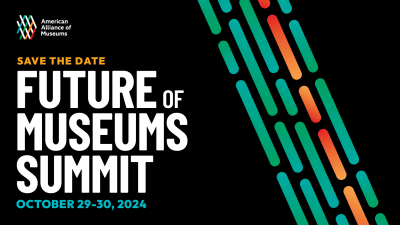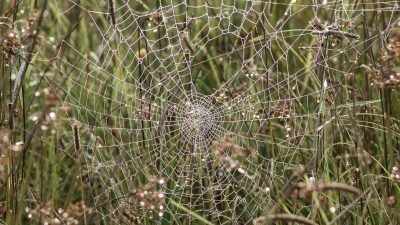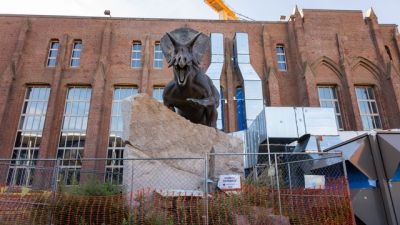
The University of Iowa Stanley Museum of Art (Stanley) is part of the arts ecosystem at the country’s premier university for the study of creative writing. As a curatorial team, we have long been aware of the unique position this puts us in to advance ekphrasis—the use of visual art for literary creation—as an effective tool for art interpretation. In a Time of Witness, a collection catalog the museum published in the fall of 2023, embodies this effectiveness. The catalog, which features original literary responses to highlights from the collection, is a collaborative effort between the museum and three of the university’s prestigious literary programs: Iowa Writers’ Workshop (IWW), the International Writing Program (IWP), and the Literary Translation Program (Translation).

In inviting contributions from diverse writers outside of the visual arts field, the project aims to make art more accessible to broader audiences by democratizing curatorial authority and de-centering whiteness—in terms of its association with colonization and imperialism—as the voice that situates and interprets art. It aligns with similar efforts toward inclusive interpretation at museums in recent years, such as the Baltimore Museum of Art’s 2022 show Guarding the Art, featuring works chosen and interpreted by seventeen museum security staff members. Though the catalog’s conception preceded the events of 2020, the global movement for equity and justice became an inspiration for the project as it developed.
Here is how the catalog took shape, and what we learned in the process about sharing authority and letting go of assumptions when you let new voices in.
Seizing the Moment
Collaborative projects between the Stanley and the University of Iowa’s world-renowned creative writing programs date back many years. For instance, when poet Jorie Graham was a faculty member at IWW in the eighties and nineties, she frequently worked with the museum and produced poems inspired by works from the collection. Engagements like Graham’s, though, were often offshoots rather than sustained programs.
Skip over related stories to continue reading article2018 would prove to be a turning point on this front. In that year, the Stanley welcomed a new director, Lauren Lessing, who led the ceremonial groundbreaking of the museum’s new building in 2019, eleven years after the Iowa River flood of 2008 forced the original building’s doors closed. Lessing’s vision for this state-of-the-art, twenty-first-century museum emphasized a more welcoming institution that re-envisioned museum practices. There was no better time than now—the museum’s fresh start and its attendant swell of goodwill—to innovate in our interpretation.

Sharing Curatorial Authority
At the outset of her tenure, Lessing encouraged curatorial staff to take on projects that would see us sharing curatorial authority in novel ways. We began by highlighting certain institutional goals that necessitated this approach: to model our ethos that art is for everyone and a launchpad for any viewer’s own creativity, to offer interpretive modes that simultaneously demonstrated art as research and research as art, to develop teaching resources for university and K-12 students, and to conceive of projects that were unprecedentedly inclusive.
A tall order for a single project, perhaps. But not so tall if we harnessed our distinction as a member of the University of Iowa’s unparalleled arts ecosystem, especially its creative writing community. Lessing and Lan Samantha Chang, Director of IWW, began having conversations about collaborative possibilities until, in the fall of 2019, the idea for a collection catalog that positioned creative writers as the only voices interpreting the artwork started to take shape. We decided we would invite alums of IWW, IWP, and Translation to write literary responses to works from the Stanley’s collections, and the program directors immediately agreed to collaborate with us on the unprecedented project.
We were especially eager to work with these programs because we recognized the great benefit in realizing our goal of inclusivity. Each one boasts a long tradition of alums whose practice and scholarship center the voices of BIPOC, LGBTQIA+, and economically underserved communities. In tapping into their alumni networks, we found ourselves with an embarrassment of riches and had our pick of writers who embodied exactly the range of diverse perspectives we hoped to feature. Thirty-one writers agreed to participate: a racially and culturally diverse group of eleven poets and ten fiction writers who are alums of IWW; five alums of IWP who would contribute literary responses in Turkish, German, Yoruba, Argentine Spanish, and Japanese; and five translators for the respective English translations.
Defying Categorization
For each commissioned writer, we offered ten to twelve artworks we thought they might be interested in responding to. The choices were based on our analyses of their literary output, through which we extrapolated their thematic preoccupations, their curiosities, and what we thought would be relevant to their lives. We confess that this was presumptuous on our part. We figured better this, though, than making the writers comb through seventeen thousand objects themselves.
We hoped contributors would bring their lived experiences to bear in their choices and responses—in fact, when the opportunity presented itself, we encouraged them to do exactly that. But we soon learned that what we understood to be their lived experiences was limited and often embarrassingly categorized. Just because, for example, the fiction writer Jamil Jan Kochai, who identifies as Afghan, centers Aghan experiences in his work does not mean he would (or should) choose an artwork from that region. He didn’t; instead, he opted for Lyonel Feininger’s In a Village Near Paris (Street in Paris, Pink Sky)—a work outside the scope of selections we presented to him. Just because Nigerian poet Tade Ipadeola would contribute a poem in Yoruba did not mean he would (or should) select an object from Nigeria. He didn’t; instead, he went with Claude Mellan’s The Sudarium of Saint Veronica, an image of Jesus Christ with a crown of thorns. Yiyun Li, who identifies as Chinese American and is celebrated for her powerful fictional portraits of Chinese and Chinese American people, would also defy expectation, going with an untitled Berenice Abbott photograph from the interwar period featuring a white woman, slouched and pensive, with a teacup at her fore.

The surprises would keep coming. We would soon realize that our presumptions about their choices were, ironically, in lockstep with exactly what we had committed to pushing against at the museum through our exhibitions and programming: art history’s penchant for geographic categorizations.
Unlocking New Perspectives
Welcoming diverse literary voices to say whatever they wanted to say about an artwork of their choice confirmed that we must release our objects from the confines of established art historical inquiries to better serve our audiences and make art more roundly accessible. After all, as In a Time of Witness demonstrates, there are things the audience has been itching to say to us.
And say the contributors did. With nuance. With care. And with clarity that expands on the respective works’ art historical narratives. Lyonel Feininger’s In a Village Near Paris (Street in Paris, Pink Sky) can be sublimely subverted in a short story like Jamil Jan Kochai’s “The Night Market in Wagh,” which recasts the setting as a village in Logar Province in eastern Afghanistan, the bustling people set against the backdrop of a longstanding war. Robert Havell Jr.’s Great Blue Heron after a drawing of J.J. Audubon—the heron a trusted American symbol—can be reimagined through a story about immigration from Taiwan to the US, as Lan Samantha Chang does in “Helen, Heron.” Claude Mellan’s The Sudarium of Saint Veronica can inspire a Yoruba praise song, Tade Ipadeola’s “Ọnà Àrà” (“Wondrous Works”), testifying to art’s inherent resistance to geographic restrictions—Mellan, a seventeenth-century French engraver, is evidenced to have created work that resonates with contemporary Nigeria.
When Juan Felipe Herrera responds to Jackson Pollock’s Mural in the poem “Future Forms Future Worlds,” he invokes Mexican muralists who had a significant influence on Pollock. A similar intersectionality is summoned in De’Shawn Charles Winslow’s “Telephone,” a short story that responds to Sam Gilliam’s Red April, a painting inspired by Martin Luther King’s assassination on April 4, 1968. In Winslow’s story, the Black American struggle for justice intersects with the pursuit of justice among queer people. Yiyun Li as well employs a transposing lens for her interpretation of Berenice Abbot’s photograph, rendering it no longer a portrait of a pensive white woman but a meditation on motherhood on a global scale.

An Organically Formed Product
When we sat down to put these literary works together in a book with a concise narrative thrust, it quickly became clear that much of that work had already been done by the writers. Free to express themselves, they had borne witness to contemporary concepts of homeland, the sacred, and freedom. In A Time of Witness, then, would be accordingly titled, and would be experienced in three thematic zones of “homeland,” “sacred,” and “freedom.”
In the catalog preface, Lessing writes, “Art is a catalyst. Like a substance that enables transformative, chemical reactions, the best art inspires creativity, innovation, and discovery.” We put this theory to the test and revealed it to be true. As museums continue to explore new, inclusive ways to engage with their collections, we hope that In a Time of Witness offers them a fresh and sustained vision for interpretation.
Funding for In a Time of Witness was generously provided by the Richard C. Von Hess Foundation and the Henry Luce Foundation.








Comments